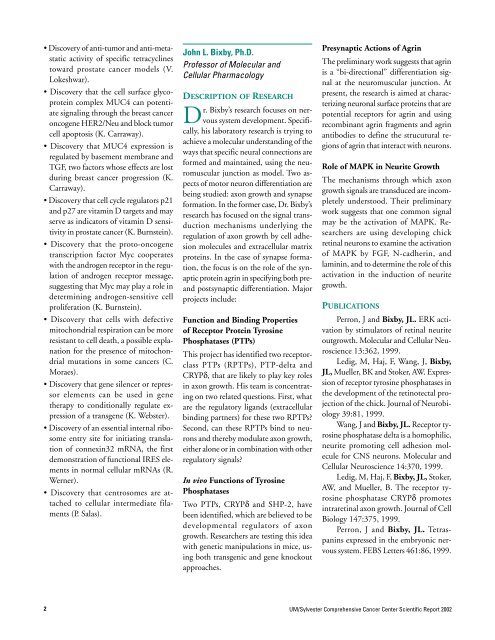tumor cell biology program - Sylvester Comprehensive Cancer Center
tumor cell biology program - Sylvester Comprehensive Cancer Center
tumor cell biology program - Sylvester Comprehensive Cancer Center
Create successful ePaper yourself
Turn your PDF publications into a flip-book with our unique Google optimized e-Paper software.
• Discovery of anti-<strong>tumor</strong> and anti-metastatic<br />
activity of specific tetracyclines<br />
toward prostate cancer models (V.<br />
Lokeshwar).<br />
• Discovery that the <strong>cell</strong> surface glycoprotein<br />
complex MUC4 can potentiate<br />
signaling through the breast cancer<br />
oncogene HER2/Neu and block <strong>tumor</strong><br />
<strong>cell</strong> apoptosis (K. Carraway).<br />
• Discovery that MUC4 expression is<br />
regulated by basement membrane and<br />
TGF, two factors whose effects are lost<br />
during breast cancer progression (K.<br />
Carraway).<br />
• Discovery that <strong>cell</strong> cycle regulators p21<br />
and p27 are vitamin D targets and may<br />
serve as indicators of vitamin D sensitivity<br />
in prostate cancer (K. Burnstein).<br />
• Discovery that the proto-oncogene<br />
transcription factor Myc cooperates<br />
with the androgen receptor in the regulation<br />
of androgen receptor message,<br />
suggesting that Myc may play a role in<br />
determining androgen-sensitive <strong>cell</strong><br />
proliferation (K. Burnstein).<br />
• Discovery that <strong>cell</strong>s with defective<br />
mitochondrial respiration can be more<br />
resistant to <strong>cell</strong> death, a possible explanation<br />
for the presence of mitochondrial<br />
mutations in some cancers (C.<br />
Moraes).<br />
• Discovery that gene silencer or repressor<br />
elements can be used in gene<br />
therapy to conditionally regulate expression<br />
of a transgene (K. Webster).<br />
• Discovery of an essential internal ribosome<br />
entry site for initiating translation<br />
of connexin32 mRNA, the first<br />
demonstration of functional IRES elements<br />
in normal <strong>cell</strong>ular mRNAs (R.<br />
Werner).<br />
• Discovery that centrosomes are attached<br />
to <strong>cell</strong>ular intermediate filaments<br />
(P. Salas).<br />
John L. Bixby, Ph.D.<br />
Professor of Molecular and<br />
Cellular Pharmacology<br />
DESCRIPTION OF RESEARCH<br />
Dr. Bixby’s research focuses on nervous<br />
system development. Specifically,<br />
his laboratory research is trying to<br />
achieve a molecular understanding of the<br />
ways that specific neural connections are<br />
formed and maintained, using the neuromuscular<br />
junction as model. Two aspects<br />
of motor neuron differentiation are<br />
being studied: axon growth and synapse<br />
formation. In the former case, Dr. Bixby’s<br />
research has focused on the signal transduction<br />
mechanisms underlying the<br />
regulation of axon growth by <strong>cell</strong> adhesion<br />
molecules and extra<strong>cell</strong>ular matrix<br />
proteins. In the case of synapse formation,<br />
the focus is on the role of the synaptic<br />
protein agrin in specifying both preand<br />
postsynaptic differentiation. Major<br />
projects include:<br />
Function and Binding Properties<br />
of Receptor Protein Tyrosine<br />
Phosphatases (PTPs)<br />
This project has identified two receptorclass<br />
PTPs (RPTPs), PTP-delta and<br />
CRYPδ, that are likely to play key roles<br />
in axon growth. His team is concentrating<br />
on two related questions. First, what<br />
are the regulatory ligands (extra<strong>cell</strong>ular<br />
binding partners) for these two RPTPs?<br />
Second, can these RPTPs bind to neurons<br />
and thereby modulate axon growth,<br />
either alone or in combination with other<br />
regulatory signals?<br />
In vivo Functions of Tyrosine<br />
Phosphatases<br />
Two PTPs, CRYPδ and SHP-2, have<br />
been identified, which are believed to be<br />
developmental regulators of axon<br />
growth. Researchers are testing this idea<br />
with genetic manipulations in mice, using<br />
both transgenic and gene knockout<br />
approaches.<br />
Presynaptic Actions of Agrin<br />
The preliminary work suggests that agrin<br />
is a “bi-directional” differentiation signal<br />
at the neuromuscular junction. At<br />
present, the research is aimed at characterizing<br />
neuronal surface proteins that are<br />
potential receptors for agrin and using<br />
recombinant agrin fragments and agrin<br />
antibodies to define the strucutural regions<br />
of agrin that interact with neurons.<br />
Role of MAPK in Neurite Growth<br />
The mechanisms through which axon<br />
growth signals are transduced are incompletely<br />
understood. Their preliminary<br />
work suggests that one common signal<br />
may be the activation of MAPK. Researchers<br />
are using developing chick<br />
retinal neurons to examine the activation<br />
of MAPK by FGF, N-cadherin, and<br />
laminin, and to determine the role of this<br />
activation in the induction of neurite<br />
growth.<br />
PUBLICATIONS<br />
Perron, J and Bixby, JL. ERK activation<br />
by stimulators of retinal neurite<br />
outgrowth. Molecular and Cellular Neuroscience<br />
13:362, 1999.<br />
Ledig, M, Haj, F, Wang, J, Bixby,<br />
JL, Mueller, BK and Stoker, AW. Expression<br />
of receptor tyrosine phosphatases in<br />
the development of the retinotectal projection<br />
of the chick. Journal of Neuro<strong>biology</strong><br />
39:81, 1999.<br />
Wang, J and Bixby, JL. Receptor tyrosine<br />
phosphatase delta is a homophilic,<br />
neurite promoting <strong>cell</strong> adhesion molecule<br />
for CNS neurons. Molecular and<br />
Cellular Neuroscience 14:370, 1999.<br />
Ledig, M, Haj, F, Bixby, JL, Stoker,<br />
AW, and Mueller, B. The receptor tyrosine<br />
phosphatase CRYPδ promotes<br />
intraretinal axon growth. Journal of Cell<br />
Biology 147:375, 1999.<br />
Perron, J and Bixby, JL. Tetraspanins<br />
expressed in the embryonic nervous<br />
system. FEBS Letters 461:86, 1999.<br />
2<br />
UM/<strong>Sylvester</strong> <strong>Comprehensive</strong> <strong>Cancer</strong> <strong>Center</strong> Scientific Report 2002
















